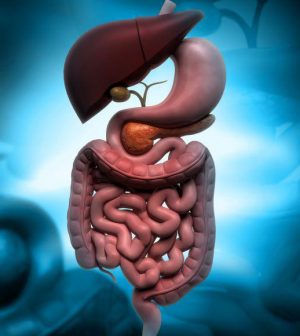- Navigating Your Midlife Crisis: Embracing New Possibilities
- City Raccoons Showing Signs of Domestication
- Mapping the Exposome: Science Broadens Focus to Environmental Disease Triggers
- One Week Less on Social Media Linked to Better Mental Health
- Your Brain Changes in Stages as You Age, Study Finds
- Some Suicide Victims Show No Typical Warning Signs, Study Finds
- ByHeart Formula Faces Lawsuits After Babies Sickened With Botulism
- Switch to Vegan Diet Could Cut Your Greenhouse Gas Emissions in Half
- Regular Bedtime Does Wonders for Blood Pressure
- Dining Alone Could Mean Worse Nutrition for Seniors
Scientists Gain New Insights Into How Small Intestine Works

It was the ancient Greeks who first divided the 20-foot length of the small intestine into three parts: The duodenum, the jejunum and the ileum.
However, the organ may finally be ready for an update: U.S. researchers say the small intestine is actually comprised of five distinct segments, each being responsible for the absorption of various nutrients.
“We’re excited because this groundwork identifies different cellular ‘neighborhoods’ within the small intestine that not only execute different intestinal functions, but also show major differences in the likelihood to develop gastrointestinal diseases, such as intestinal cancers, ileitis [a common type of inflammatory bowel disease] and celiac disease,” said study lead author Rachel Zwick.
“These regional molecular and cellular differences help us better understand these diseases,” added Zwick, who is an American Cancer Society Postdoctoral Fellow at the University of California, San Francisco.
She spoke in an news release from Cedars-Sinai in Los Angeles, which helped with the research.
According to the researchers, their work examined the “geography” of the small intestine across multiple species, including mice and humans. Overall they tracked the makeup of 30 different sections of the organ.
Part of their investigation was genetic: Zwick and her colleagues identified genes that appeared to be responsible for nutrient absorption at various spots along the small intestine.
That helped them to determine the number of distinct regions in the small intestine, and what each might be responsible for.
Overall, they counted five distinct regions along the length of the organ.
“Each domain is associated with different aspects of nutrient absorption, and each exhibits distinct responses to changes in diet,” the Cedars-Sinai news release said.
What’s more, research involving cell cultures in the lab showed that cells taken from various intestinal regions “remembered” aspects of their molecular signatures even one month after being removed from the organ.
That could give clues to how the small intestine successfully regenerates itself over the life span, the research team explained.
Three regions that are each home to distinct intestinal stem cell types also exist within the small intestine, the scientists discovered.
The findings were published Feb. 6 in the journal Nature Cell Biology.
“As far as we know, this is the first study to molecularly define the regions of the small intestine,” said study co-senior author Dr. Ophir Klein, executive director of Cedars-Sinai Guerin Children’s. “This is information scientists can use to understand the cellular and molecular processes that occur in the small intestine and what goes wrong in gastrointestinal diseases.”
More information
Find out more about the small intestine at the Medical University of South Carolina.
SOURCE: Cedars-Sinai, news release, Feb. 6, 2024
Source: HealthDay
Copyright © 2025 HealthDay. All rights reserved.










